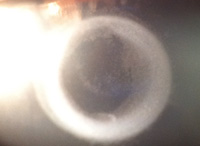 History
History
A 47-year-old black female presented for a routine eye examination. Her systemic history was unremarkable. She reported no known allergies of any kind.
 |
|
Anterior segment image of our 47-year-old patient who presented for a routine exam. What is the correct diagnosis?
|
Her best-corrected entering visual acuity measured 20/20 OU at distance and near. Her external examination was normal, with no evidence of afferent pupillary defect OU. The biomicroscopic examination of the anterior segment was normal in both eyes. Intraocular pressure measured 15mm Hg OU. We documented no peripheral pathologies in either eye. The pertinent clinical findings are illustrated in the photograph.
Your Diagnosis
How would you approach this case? Does the patient require any additional tests? What is your diagnosis? How would you manage this patient? What is the likely prognosis?
Discussion
Additional studies included sodium fluorescein stain instillation and photodocumentation. The diagnosis in this case is alcohol-induced corneal epithelial toxicity secondary to the application of a four-mirror gonio lens that wasn’t properly dried by our staff intern after being sanitized with an alcohol wipe. Chemical injury to the cornea may result secondary to exposure to an alkali or acidic solution. In order to avoid permanent ocular surface damage, these emergent injuries require immediate intervention.1-5
'Chemical injuries generally occur more frequently in males than in females (58.4% vs. 41.6%), with most insults reported in the warmer months.1 Most ocular chemical burns are caused by cleaning agents, personal care products and automotive solvents.1
Typically, in-office first aid includes irrigation of the upper and lower fornices with eyelid eversion for at least five minutes. When patients present with a chief complaint of chemical injury, first aid must be applied immediately––even before patient history or formal examination––so long as the chemical agent can be identified and its manufacturer recommends dilution under such circumstaces.2
If patients call to report a chemical insult, and irrigation is clinically advisable, instruct them to flush out their eye immediately before presenting to the office. In the office, use a litmus paper strip to measure ocular pH levels (ideal is 7.0 to 7.2). To ensure that there is no residual particulate matter, the conjunctiva should be inspected under the biomicroscope. Be sure to stain the tissue with fluorescein dye to illuminate areas of damage. Also, measure baseline intraocular pressure.3 The primary treatment goal is to promote epithelial healing by preventing infection and reducing inflammation. In some instances, bulky, necrotic tissue must be removed to facilitate proper healing.
For mild corneal toxic reactions, where only the corneal epithelium is involved with no limbal ischemia, the patient should receive cycloplegia (cyclopentolate, scopalomine, homoatropine or atropine, depending upon the severity), a fourth-generation topical antibiotic drop during waking hours (QID to Q2H, depending upon the size and severity of the epitheliopathy) and topical antibiotic ointment at bedtime (e.g., erythromycin 0.5%).
Topical nonsteroidal anti-inflammatory preparations (NSAIDs) can be prescribed BID to QID to mitigate pain, along with cold compresses, artificial tears and oral over-the-counter analgesics. Corticosteroid drops can be prescribed for more severe exposures to help decrease inflammation. In the event that aggressive infiltration occurs with or without corneal hazing and limbal ischemia, topical steroidal drops should be applied every hour until improvement is observed. The drops can be tapered quickly thereafter to decrease the risk of corneal melting.
Oral tetracycline antibiotics (e.g., doxycycline) have been used experimentally for both antimicrobial and anti-inflammatory purposes. Research suggests that high doses of oral vitamin C may help decrease ulceration rates in patients with chemical injury by enhancing collagen crosslinking and promoting enhanced healing.4 In the event of an intraocular pressure increase secondary to either an iritis produced by the injury or a steroid response, a topical beta-blocker, alpha-adrenergic agonist, carbonic anhydrase inhibitor or a combination ocular hypotensive medication can be used to re-establish control.3 The patient should be monitored daily to ensure epithelial regrowth without the presence of infection. More severe chemical burns may require surgical treatment or the instillation of amniotic transplantation graft, such as ProKera (Bio-Tissue).5
A tenonplasty also can be attempted to increase the limbal vascular blood supply and stimulate the localized stem cells to catalyze corneal re-epithelialization.6 If the damage is too extensive, chronic limbal stem cell deficiency can be treated with an autograft from the contralateral eye, or an allograft if both eyes are involved.4 Our patient underwent an emergent lavage, in-office cycloplegia with cyclopentolate, and instillation of a fourth-generation antibiotic drop and a topical NSAID. We also educated her about the therapeutic benefits of supportive care, including cold compress therapy, artificial tears and over-the-counter analgesics.
Her cornea returned to normal in approximately 30 hours. The antibiotic and supportive topical agents were continued QID for five days, then discontinued. Fortunately, she experienced no long-term complications.
Thanks to Brendan Pancott, OD, of Philadelphia for his contributions to this case.
1. Sher LM, Taylor DM, Robinson J, et al. The epidemiology of chemical eye exposures reported to the Victorian poisons information centre. Eur J Emerg Med. 2012 Dec;19(6):389-94. 2. Rodrigues Z. Irrigation of the eye after alkaline and acidic burns. Emerg Nurse. 2009 Dec;17(8):26-9 3. Lin MP, Ekşioğlu Ü, Mudumbai RC, et al. Glaucoma in patients with ocular chemical burns. Am J Ophthalmol. 2012 Sep;154(3):481-5.e1. 4. Hemmati H, Colby K. Treating acute chemical injuries of the cornea. Eyenet. 2012 Oct;9(10):42-5. 5. Kheirkhah A, Johnson DA, Paranjpe DR, et al. Temporary sutureless amniotic membrane patch for acute alkaline burns. Arch Ophthalmol. 2008 Aug;126(8):1059-66. 6. Liu J, Sheha H, Fu Y, et al. Update on amniotic membrane transplantation. Exp Rev Ophthalmol. 2010 Oct;5(5):645-61.

